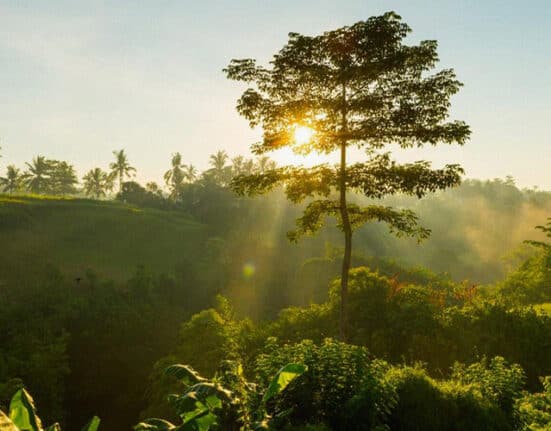IN RECENT years, the Philippines has experienced a series of unpredictable weather patterns, witnessing scorching heat in the mornings giving way to torrential rain in the afternoons.
The intense heat that Filipinos are currently experiencing as the country slowly shifts to the dry season is somewhat reminiscent of what happened during the El Niño phenomena last year.
This fluctuation between dry and wet seasons, intensified by climate change, poses serious challenges to both urban and rural areas. Filipinos are having a hard time figuring out how to combat these weather patterns.
Look Back on 2024
Looking back, 2024 was a year of class suspensions caused by major flooding and typhoons, as well as the intense heat throughout the first half of the year.
The El Niño phenomenon, which began in July 2023 and peaked in early 2024, had a considerable influence on the country, including drought conditions that devastated agricultural fields and fishing areas.
On June 7, 2024, the state weather bureau PAGASA formally announced that the phenomenon had already ended. However, Filipinos were advised to brace for its counterpart, La Niña.
Excessive heat is always accompanied by excessive rainfall. La Niña is expected to happen between August and October 2024. At its apex, seven consecutive typhoons destroyed the country in just one month.
This occurred around November, when Severe Tropical Storm Kristine, Super Typhoon Leon, Typhoon Marce, Nika, Ofel, and Super Typhoon Pepito each wreaked havoc on the country.
In the midst of this climatic rollercoaster, what can we do to protect ourselves from these natural disasters? Without a doubt, there is only one reliable ally who can help alleviate the effects of these destructive weather patterns: trees.
Also read: El Nino and its effects on Gen Zs’ mental health
Heart and Soul of Nature
Trees, which are frequently overlooked, are more than just charming features of the landscape; they are critical to the health of the environment, the well-being of its people, and the nation’s resistance to natural calamities.
If we were to describe trees, we would say they are the heart and soul of nature, combating heat during the blazing dry season and preventing flooding during the rainy season, making them essential for beating the weather in the country.
Given the country’s geographical location and the growing issues of climate change, trees play an important role in sustaining the local weather and ecology while also ensuring individual well-being.
“Trees have lots of benefits and tree growing is an essential way countries across the globe are doing to avert the harsh impacts of climate change,” the Department of Environment and Natural Resource (DENR) said in their website.
“We have seen the damage it wrought upon us in the form of super typhoons, monsoon rains, landslides, and erratic weather conditions,” DENR’s statement went on to say.
Trees are essential to both the natural ecology and the well-being of the Filipino people, regardless of the country’s situation. They regulate the climate and provide a barrier against natural disasters.
Now that we’ve established the importance of trees, let’s look at how they help us during both the dry and wet seasons, given that when trees cover our cities, they change the weather.
Shielding Against the Heat
Last year, the country witnessed record-breaking high temperatures in April and May. During this season, a lack of rain can cause parched landscapes, worsening droughts, and water shortages.
The heat grew even more intolerable in urban areas due to the phenomenon known as the “urban heat island effect,” in which concrete and asphalt trap heat and raise temperatures to uncomfortable extremes.
Given the conditions, the significance of trees cannot be emphasized. Trees, with their large canopies, offer shade that cools the surroundings, making outdoor places more comfortable during the dry season.
In reality, trees can reduce ambient temperatures by up to 2-8°C (36-46°F) in metropolitan areas by functioning as natural air conditioners. It also adds to a decrease in temperature by cooling the surrounding air.
This is especially critical in densely populated locations like Metro Manila, where high temperatures can cause heat stroke and dehydration. Trees improve inhabitants’ comfort while lowering the demand for energy-consuming air conditioning systems.
Furthermore, the DENR claims that trees are critical in combatting air pollution, which is sometimes worse during the dry season. When there isn’t enough rain to clear the air, dust and haze from cars and factories linger.
Trees operate as natural air purifiers by absorbing CO2, filtering out contaminants, and emitting oxygen. In this way, they help not only to chill the atmosphere, but also to improve air quality, which is critical to public health.
Preventing Floods and Erosion
When the rainy season arrives, which normally occurs between June and November, the country undergoes a significant change. From a stove-like heat, the country enters a season of gloomy and cold days.
This will be combined with the strong downpours that characterize the wet season, which frequently cause extensive flooding, particularly in urban areas where drainage systems are typically inadequate.
Flooding disrupts communities, destroys infrastructure, and results in huge economic losses. Just like in the dry season, trees once again demonstrate their important value during this phenomenon.
“The roots of trees hold the soil in place as it fights erosion that causes landslides. It also absorbs and stores rainwater that helps reduce runoff and sediment deposit after the storms,” the DENR said.
“It also helps recharge ground water supply, prevents transport of chemicals into streams as well as prevents flooding,” the department added.
Furthermore, trees operate as natural barriers against typhoons in landslide-prone places such as Bicol, the Cordillera Administrative Region, and Cagayan province. The Sierra Madre dissolved or weakened many typhoons last year, which is living proof.
Meanwhile, urban trees planted along roadsides and in parks absorb rainwater, which can overload drainage systems. This lowers the frequency and severity of urban flooding, making cities more resilient to the effects of climate change.
A Greener Future for the PH
The Philippines, with its distinct tropical environment, has considerable challenges as the dry and wet seasons fluctuate. Yet, the remedy is as easy and natural as planting trees.
Trees are more than just a heat shield or a flood barrier; they are an essential part of the country’s environmental and social fabric. Which emphasizes the necessity of native tree planting.
By preserving and expanding the country’s tree cover, the Philippines may make significant progress in combatting climate change, enhancing resilience, and safeguarding its people from increasingly unpredictable weather patterns.
As the climate continues to change, it is evident that the Philippines’ strongest defense resides in its tree roots, which are deep, steadfast, and intertwined with the nation’s heart.
How useful was this post?
Click on a star to rate it!
Average rating 1 / 5. Vote count: 1
No votes so far! Be the first to rate this post.
We are sorry that this post was not useful for you!
Let us improve this post!
Tell us how we can improve this post?






